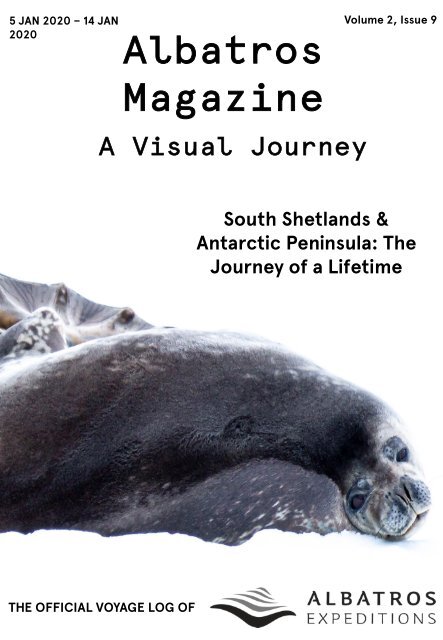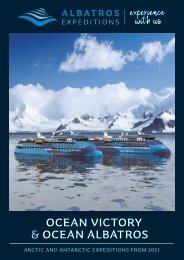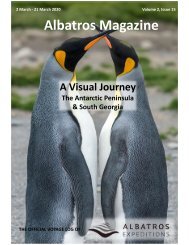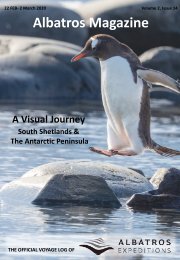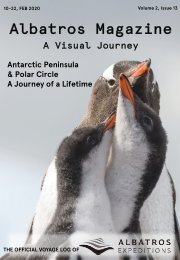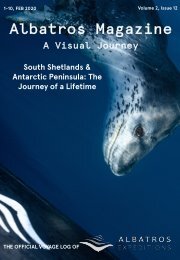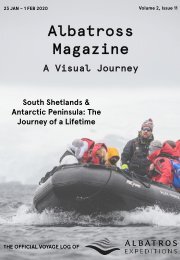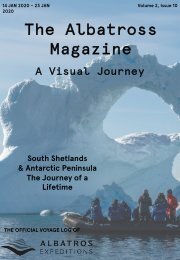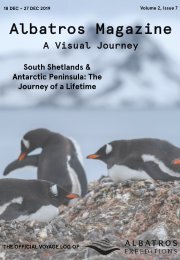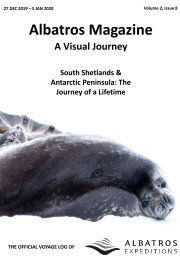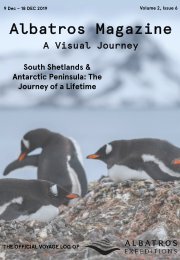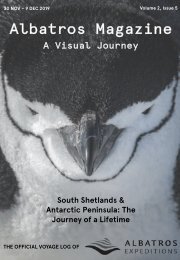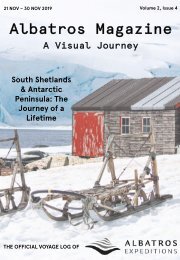V9 Antarctic Peninsula_Voyage_Log
You also want an ePaper? Increase the reach of your titles
YUMPU automatically turns print PDFs into web optimized ePapers that Google loves.
5 JAN 2020 – 14 JAN<br />
2020<br />
Albatros<br />
Magazine<br />
Volume 2, Issue 9<br />
A Visual Journey<br />
South Shetlands &<br />
<strong>Antarctic</strong> <strong>Peninsula</strong>: The<br />
Journey of a Lifetime<br />
THE OFFICIAL VOYAGE LOG OF
Albatros Magazine: A Visual Journey<br />
Editor-in-Chief:<br />
Layout & Design:<br />
Contributing Writers:<br />
Traynor,<br />
Dalsgaard,<br />
Martin Schuster<br />
Gaby Pilson<br />
Heidi Ahvenainen, Thomas Bauer, Sara Hoffritz, Sandra Ophorst, Steve<br />
Steve Egan, David Macdonald, Gregers Gjersøe, Gaby Pilson, Amanda<br />
Martin Schuster<br />
Front Cover Image:<br />
Back Cover Image:<br />
Photography Contributors:<br />
Weddell seal © Gaby Pilson<br />
Chinstrap Penguin © Renato Granieri<br />
Renato Granieri<br />
Yuri Choufour<br />
Werner Kruse<br />
Gaby Pilson<br />
5 JAN 2020 – 14 JAN<br />
Volume 2, Issue 9
TABLE OF CONTENTS<br />
The <strong>Voyage</strong><br />
Meet the Team<br />
Day 1: Southward Bound<br />
The Seven Sisters of Szczecin<br />
An Unlikely <strong>Antarctic</strong> Explorer<br />
Day 2: Rolling Our Way South<br />
Penguins! Fun Facts for the <strong>Antarctic</strong><br />
Adventurer<br />
Day 3: Approaching the Ice<br />
Ice is Nice – Glacier Fun Facts<br />
Whales: Friendly Giants of the Sea<br />
Day 4: Chasing Icebergs, Finding Penguins<br />
The Geological Structure of the <strong>Antarctic</strong><br />
<strong>Peninsula</strong><br />
Day 5: The White Continent<br />
When and How the Earth Got Cold<br />
Day 6: South, Way South<br />
Day 7: Deception Island<br />
A Brief History of the Zodiac<br />
<strong>Antarctic</strong>a: A Continent for Science<br />
Day 8: Northward Bound<br />
Fire in the <strong>Antarctic</strong><br />
Day 9: Towards the Horn<br />
King of the Southern Winds<br />
Day 10: Home Again<br />
By the Numbers<br />
A Final Note<br />
3<br />
4<br />
5<br />
6<br />
7<br />
8<br />
9<br />
10<br />
11<br />
13<br />
14<br />
15<br />
16<br />
17<br />
19<br />
20<br />
21<br />
23<br />
24<br />
25<br />
26<br />
27<br />
29<br />
30<br />
31
The <strong>Voyage</strong><br />
The following map illustrates the approximate route taken by M/V Ocean Atlantic during our voyage<br />
to <strong>Antarctic</strong>a. You can find more information about our day to day activities, landings, and<br />
excursions on the following pages. We hope that this magazine serves as a reminder of all of the<br />
wonderful memories you made while experiencing the <strong>Antarctic</strong> with us at Albatros Expeditions.<br />
3<br />
5 JAN 2020 – 14 JAN 2020<br />
Volume 2, Issue 9
Meet the Team<br />
4<br />
Phil Hunter<br />
Assistant Expedition<br />
Leader<br />
Jamie Watts<br />
Expedition Leader<br />
Marieke Egan<br />
Assistant Expedition<br />
Leader<br />
Shelli Ogilvy<br />
Zodiac Master<br />
Thomas Morgensen<br />
Kayak Guide<br />
Steve Egan<br />
Kayak Master<br />
Thomas Bauer<br />
Lecturer & Guide<br />
Nadine Smith<br />
Shop Manager<br />
Slava Nikitin<br />
Kayak Master<br />
Guillaume de Remacle<br />
Lecturer & Guide<br />
Renato Granieri<br />
Photographer<br />
Steve Traynor<br />
First Aid Team Leader<br />
Marc Hebert<br />
Lecturer & Guide<br />
Amanda Dalsgaard<br />
Lecturer & Guide<br />
Martin Shuster<br />
Lecturer & Guide<br />
Sara Hoffritz<br />
Lecturer & Guide<br />
Heidi Ahvenainen<br />
Equipment Master<br />
Chloe Zhang<br />
Shop Assistant<br />
Deng Weixi<br />
Translator & Guide<br />
Sandra Ophorst<br />
Lecturer & Guide<br />
Jes (Yeti) Graugaard<br />
Ornithologist & Guide<br />
5 JAN 2020 – 14 JAN 2020<br />
Volume 2, Issue 9
5<br />
Southward Bound<br />
5 January 2019 - Embarkation Day<br />
Written by Martin Schuster<br />
This afternoon most of us were excited to embark<br />
the Ocean Atlantic in anticipation of our trip to the<br />
<strong>Antarctic</strong> <strong>Peninsula</strong>. At 14:00 the first bus arrived<br />
and the team on board welcomed us with bright<br />
smiles, a cocktail, and also some necessary<br />
paperwork. Afterwards everybody settled into<br />
their cabins, explored their new home for the next<br />
nine days, and enjoyed some afternoon tea.<br />
At 16:15 our Expedition Leader, Jamie Watts,<br />
invited us into the Viking Theatre for a mandatory<br />
safety briefing followed by a lifeboat drill. We all<br />
learned about SOLAS, Safety of Life at Sea, and<br />
were taken to our life boat stations simulating a<br />
general emergency. As soon as this was completed,<br />
the anchor was lifted and we set sail, leaving the<br />
Port of Ushuaia on our way to the <strong>Antarctic</strong><br />
<strong>Peninsula</strong>!<br />
After a small break, during which we were able to<br />
explore our new home, we were invited once again<br />
into the Viking Theatre for an introduction to the<br />
ship and its key personnel. Our hotel director,<br />
Oliver, introduced the key people in the hotel<br />
department such as our food and beverage<br />
manager, purser, and head of housekeeping. Jamie<br />
then introduced us to the entire Expedition Team<br />
and also informed us that we could expect a ‘good<br />
drake’, meaning that the weather forecast for the<br />
crossing was excellent.<br />
Jamie also explained the difference between cruise<br />
ships and expedition ships, and it was clear that we<br />
were on the right vessel. We were at the start of a<br />
proper expedition voyage.<br />
At 19:15 the formalities were over and we all headed<br />
down for dinner in the Vinland restaurant. The hotel<br />
team prepared a lovely buffet dinner and we spent the<br />
next hour or so mingling with some of our fellow<br />
travellers.<br />
After dinner, many of us went up to the outer decks to<br />
enjoy the scenic views of the Beagle Channel. The<br />
conditions were beautifully calm and the sun was<br />
slowly setting.<br />
Step by step it became quieter around the Ocean<br />
Atlantic as many retired early after the long<br />
international journey.<br />
True to Jamie’s word, the crossing began with calm<br />
seas, and we all fell into a restful sleep.<br />
5 JAN 2020 – 14 JAN 2020<br />
Volume 2, Issue 9
The Seven Sisters of Szczecin<br />
David Macdonald, Lecturer (Geology) & Expedition Guide<br />
M/V Ocean Atlantic was launched in 1986 as the last-built of the ‘Shoshtakovich’ class of ice-strengthened<br />
passenger vessels, alongside six sister ships, together known as the “Seven Sisters of Szczecin.<br />
6<br />
Her original name was Konstantin Chernenko<br />
(Константин Черненко), after the President of the<br />
USSR (1984-1985). She was renamed Russ (Русс) in<br />
1989, and spent much of her life working in the Russian<br />
Far East.<br />
She was purchased by Albatros Expeditions and<br />
completely refitted in 2017. She is now a 200-<br />
passenger expedition vessel and is one of the strongest<br />
polar cruise ships afloat. Here are some fun facts about<br />
the “Seven Sisters”:<br />
• All seven ships were built by Stocnia Szczecinska<br />
shipyard in Szczecin, Poland between 1979-1986<br />
• Main engines: 4 x Skoda Sulzer 6LZ40 total power<br />
12800 kW, giving a maximum speed of 18 knots<br />
• Most of the class have one bow thruster (736 kW)<br />
and one stern thruster (426 kW); however, two<br />
ships, including ours, built in 1986, have two stern<br />
thrusters, each of 426 kW<br />
• Feature Siemens stabilisers for seaworthiness<br />
• Although built as ferries, they have a strengthened<br />
car deck for transport of tanks<br />
• Two of them had diving chambers<br />
• MV Mikhail Sholokov had hull demagnetising<br />
equipment so it could operate in minefields<br />
• All of these ships have been scrapped except ours<br />
and Konstantin Simonov – now Ocean Endeavour<br />
Our ship has had a complex history:<br />
1986-1987 In Baltic traffic, then Vladivostok to<br />
Japan & S Korea<br />
1989 renamed to Russ<br />
1997-1999 In traffic Stockholm-Riga; 2000<br />
Odessa-Haifa; 2002 back to<br />
Vladivostok transporting cars from<br />
Japan<br />
2007 Sold to Sea Ferry Shipping in Majuro<br />
and renamed 2010 to Atlantic;<br />
renovations in Italy and in traffic<br />
Stockholm-Helsinki-St. Petersburg<br />
during summer and laid up (October<br />
2010) in St Petersburg<br />
2012 Sold to ISP in Miami and renamed to<br />
Ocean Atlantic under Marshall<br />
Islands flag<br />
2013 Used as a hotel ship in the German<br />
bight wind farm project<br />
2015-2017 Laid up in Helsingborg and taken to<br />
Gdansk in Poland, where totally<br />
refitted<br />
2017 Chartered to Quark Expeditions<br />
2017-present Chartered to Albatros Expeditions.<br />
5 JAN 2020 – 14 JAN<br />
Volume 2, Issue 9
An Unlikely <strong>Antarctic</strong> Explorer<br />
Gregers Gjersøe – Snowshoe Master & Expedition Guide<br />
In a suburb of Wellington, New Zealand, the local<br />
cemetery is home to a rather unassuming grave.<br />
The final resting place of Henry “Chippy” McNish,<br />
one of the survivors of Sir Ernest Shackleton’s<br />
1914 Endurance Expedition, the grave is also a<br />
memorial to one of the most improbable of<br />
<strong>Antarctic</strong> explorers.<br />
In January of 1915, the Endurance got trapped in<br />
the <strong>Antarctic</strong> pack ice. McNish's work prevented<br />
the ship from flooding, but he couldn’t do<br />
anything to stop it from being crushed. The ship<br />
was abandoned and, much to McNish’s despair,<br />
Shackleton ordered Mrs. Chippy to be shot, as<br />
they couldn’t take her on their survival journey.<br />
7<br />
McNish himself was a carpenter onboard the<br />
Endurance, though he didn’t travel alone. During<br />
the expedition, McNish brought along a cat that<br />
followed him around like an overpossessive<br />
wife. Soon enough, the<br />
crew named the cat Mrs. Chippy,<br />
although the expedition quickly<br />
realised that Mrs. Chippy was a<br />
gentleman, not a lady.<br />
Mrs. Chippy was an unusual cat,<br />
though an avid adventurer,<br />
having climbed the Endurance’s<br />
rigging lines on several<br />
occasions. Mrs. Chippy also did<br />
some very provocative strolls<br />
across the roofs of the dogs’ kennels<br />
and even once fell into the frigid water<br />
below. Thankfully, the crew heard her cries and<br />
quickly turned the ship around so they could<br />
pluck her up from the icy cold waters and get her<br />
to safety.<br />
Also onboard the Endurance was a young man -<br />
Perce Blackborow. Perce had travelled to Buenos<br />
Aires looking for new employment, but wasn’t<br />
hired; at 18, his youth and inexperience counted<br />
against him. Somehow, he managed to sneak<br />
aboard the ship, and he hid in a clothing locker<br />
for three days. Eventually, he was discovered,<br />
and Shackleton was furious with him, but was<br />
sent to work in the galley where he became great<br />
friends with Mrs. Chippy.<br />
Now, the group had to make it back to safety. For<br />
months, the expedition drifted through icy<br />
waters until they made it to Elephant Island.<br />
Once at Elephant Island, Shackleton set out<br />
in a 22-foot-long open boat and made<br />
an 800-mile crossing through the<br />
rough waters of the South Atlantic<br />
to South Georgia. McNish was<br />
one of the five men who<br />
accompanied Shackleton,<br />
making improvements to the<br />
boat to make the voyage<br />
possible.<br />
For the next fifteen years, McNish<br />
lived a difficult life in Wellington<br />
before passing away in 1930. He never<br />
forgave Shackleton for shooting Mrs.<br />
Chippy.<br />
Nearly 30 years later, in 1959, the New Zealand<br />
<strong>Antarctic</strong> Society realised that McNish had been<br />
given a very poor burial in an unmarked grave.<br />
The Society raised funds for a headstone and<br />
even reunited McNish and Mrs. Chippy by adding<br />
a life-sized bronze statue of Mrs. Chippy to the<br />
grave.<br />
Now Karori Cemetery near Wellington is a<br />
pilgrimage site for <strong>Antarctic</strong> history buffs, who<br />
visit McNish’s grave and see Mrs. Chippy<br />
watching over him once again.<br />
5 JAN 2020 – 14 JAN 2020<br />
Volume 2, Issue 9
Rolling Our Way South<br />
6 January 2020 – Drake Passage<br />
By Heidi Ahvenainen<br />
8<br />
It was the first morning of our expedition, a time<br />
many have been waiting for. The adventure had<br />
started! Some of us were awoken by Jamie’s<br />
wake-up call at 7:45 AM, but others were already<br />
up and about, enjoying the infamous Drake<br />
Passage and trying to spot the wandering<br />
Albatross and other sea birds. The Drake treated<br />
us like an old friend on our first day and the sailing<br />
was as smooth as Jamie had promised.<br />
The day ahead was full of lectures and briefings<br />
on what we could look forward to during our<br />
expedition to <strong>Antarctic</strong>a. The first lecture was<br />
given by our resident ornithologist, Gui. He<br />
educated us on seabirds of the Drake Passage,<br />
and even the people who were not experienced<br />
with bird identification were inspired to admire<br />
the majestic seabirds of the Southern Ocean.<br />
The briefing was followed by an opportunity for<br />
all guests to bring their outer wear for inspection<br />
and cleaning by the expedition team to ensure<br />
that no seeds or foreign matter would<br />
contaminate our landing sites. All throughout the<br />
day’s activities, the Albatros team kept a lookout<br />
from the bridge in the hope of spotting marine<br />
life.<br />
Afternoon tea time brings a break to the day and<br />
a chance for even more delicious snacks. We<br />
were beginning to realize that we would not go<br />
hungry on this expedition. For those of us<br />
interested in kayaking, a preliminary briefing was<br />
held in the Viking lounge to explain how the<br />
program runs.<br />
Our second lecture of the morning was given by<br />
our resident photographer Renato. He equipped<br />
many of us with the skills necessary to capture the<br />
wildlife and scenery of <strong>Antarctic</strong>a on our cameras.<br />
After a delicious lunch, afternoon activities began<br />
with a mandatory briefing about visiting<br />
<strong>Antarctic</strong>a, where we were all reminded of how<br />
we are expected to behave in this fragile<br />
environment and how to leave it pristine.<br />
It’s always nice to meet the most important man<br />
on the vessel, and in the evening Captain Mykola<br />
invited everyone to the Viking lounge for a<br />
cocktail and a chance to introduce himself and his<br />
senior officers. Champagne and canapés were<br />
enjoyed before a delicious dinner in the Vinland<br />
restaurant. To wrap up the evening, we finished<br />
with a screening of the Frozen Planet<br />
documentary series in the Viking lounge, with<br />
popcorn!<br />
5 JAN 2020 – 14 JAN 2020<br />
Volume 2, Issue 9
Penguins! Fun Facts for the <strong>Antarctic</strong> Adventurer<br />
Gaby Pilson, Hiking Master & Expedition Guide<br />
For many of us, the chance to see penguins waddling around in the snowy vastness of <strong>Antarctic</strong>a is the reason<br />
that we came to the White Continent. These charismatic sea birds are a fan-favourite for visitors to <strong>Antarctic</strong>a,<br />
but even cuddly-looking penguins are incredibly well adapted to one of the harshest environments on Earth.<br />
1<br />
2<br />
Depending on what book you read, there are 19<br />
species of penguins. If you count all of the<br />
subspecies, there are 25 total varieties of<br />
penguins in the world, however, there are only<br />
four truly <strong>Antarctic</strong> species of penguins: the<br />
Adélie, Gentoo, Chinstrap, and Emperor. All of<br />
the other penguins in the world live south of the<br />
equator yet north of <strong>Antarctic</strong>a, with the<br />
exception of one species in the Galapagos whose<br />
range barely crosses into the northern<br />
hemisphere.<br />
The largest penguin to have ever lived was the<br />
now-extinct mega penguin, which weighed some<br />
115 kg. These days, the largest penguin is the<br />
Emperor Penguin, which tips the scales at 23 kg.<br />
Alternatively, the smaller gentoo penguin weighs<br />
just 15 kg.<br />
9<br />
3<br />
4<br />
5<br />
Although they nest, breed, and socialize on land,<br />
penguins rely on the sea for survival. As<br />
swimming and diving birds, penguins are adept<br />
at fishing and must head to the ocean for their<br />
sustenance. Indeed, the deepest diving bird in<br />
the world is the Emperor Penguin, with a<br />
record-breaking dive of 535 meters!<br />
Penguins are amazing swimmers. They spend<br />
much of their day searching for food in the<br />
ocean, particularly for their favourite meal of<br />
krill, squid, and small fish. The fastest swimming<br />
penguin is the Gentoo, which is known to reach<br />
speeds of upwards of 50 kilometres an hour<br />
while zooming through the water.<br />
Penguins are highly social birds, choosing to<br />
nest in large colonies, where they will also raise<br />
their young. Many penguin chicks, after<br />
hatching stay with their parents for a few weeks<br />
to a few months before forming large “crechés,”<br />
many hundreds of individual teenage penguins<br />
in size.<br />
5 JAN 2020 – 14 JAN 2020<br />
Volume 2, Issue 9
Approaching the ice<br />
7 January 2020 – Drake Passage & S. Shetland<br />
Islands<br />
Written by Thomas Bauer<br />
10<br />
Our smooth crossing continued and in the morning<br />
in cloudy and foggy conditions we discovered that<br />
during the night we had crossed 60 degrees South<br />
and that we were now officially in <strong>Antarctic</strong>a. The<br />
fog further indicated that we had reached the<br />
<strong>Antarctic</strong> Convergence, the biological boundary of<br />
<strong>Antarctic</strong>a, where the cold waters from the south<br />
subside under the warmer waters from the north.<br />
During the morning Gui gave us a very<br />
comprehensive presentation on the different<br />
<strong>Antarctic</strong> penguins we hope to encounter during<br />
our voyage. His lecture was followed by a<br />
mandatory briefing on how to get in and out of the<br />
inflatable Zodiac boats. Without these very sturdy<br />
boats our landings in <strong>Antarctic</strong>a would not be<br />
possible.<br />
After lunch, our Kayak guides Slava and Toto<br />
conducted a briefing on our kayak operations and<br />
a significant number of guests expressed an<br />
interest to experience <strong>Antarctic</strong>a from a kayak.<br />
As we approached the South Shetland Islands in<br />
still fairly foggy conditions the bridge reported<br />
that the first iceberg had been spotted on the<br />
radar. No visual sighting had been possible so far.<br />
In the afternoon our geologist Sara gave us a very<br />
informative lecture on the geology of <strong>Antarctic</strong>a<br />
and this was later followed by a presentation by<br />
guest presenter Dr. Bo Eberling on the very<br />
current topic of climate change and greenhouse<br />
gases.<br />
After the briefing we all headed to the mudroom<br />
to be issued with a pair of rubber boots. These will<br />
keep our feet nice and dry during the wet landings<br />
we will experience during our excursions.<br />
During the evening briefing our expedition leader<br />
announced that tomorrow we may be in a position<br />
to set eyes on an iceberg knows as A 68. At 5,800<br />
square kilometres A 68 is one of the largest<br />
icebergs ever recorded.<br />
After dinner we had the opportunity to listen to a<br />
presentation by Dr. Elise Biersma on the topic of<br />
polar ecology and adaptations to extreme<br />
<strong>Antarctic</strong> climate.<br />
© Renato Granieri<br />
5 JAN 2020 – 14 JAN 2020<br />
Volume 2, Issue 9
Ice is Nice – Glacier Fun Facts<br />
Gaby Pilson, Hiking Master & Expedition Guide<br />
Glaciers have, quite literally, shaped our world. Without glaciers, the rolling hills and wide valleys we know<br />
today would look very different, but it turns out that these icy giants have a much longer and more storied<br />
history than many of us would initially suspect. Here are some of the best fun facts about glaciers:<br />
11<br />
1<br />
Not just anything can be a glacier. In fact, there’s<br />
a size requirement that a piece of ice has to<br />
meet to become a glacier. Anything considered a<br />
glacier must be at least 0.1 km 2 (nearly 25 acres)<br />
in area to be worthy of the name. Although<br />
there’s a minimum size requirement to be<br />
considered a glacier, there’s no upper limit to<br />
glacierhood. The longest glacier on earth is the<br />
Lambert Glacier of <strong>Antarctic</strong>a, which measures<br />
out to some 434 km (270 mi) long. The world’s<br />
largest non-polar glacier is the Fedchenko<br />
Glacier of Tajikistan, which measures a<br />
respectable 77km (48mi) long.<br />
2<br />
Glaciers are formed by snowflakes. Although it’s<br />
crazy to think that a tiny snowflake can create<br />
something as large as a glacier, without snow,<br />
glaciers would never exist in the first place. To<br />
form a glacier, massive amounts of snow must<br />
accumulate and persist in a single location all<br />
year long for hundreds, if not thousands of<br />
years. During this time, the individual snowflakes<br />
found in the snowpack change in a process<br />
known as snowflake metamorphosis, where<br />
individual ice grains fuse together and get bigger<br />
and air bubbles get smaller. Once the icepack<br />
builds up enough mass to start flowing downhill,<br />
then, voila! We have a glacier.<br />
3<br />
Glaciers are found all over the world, not just in<br />
the polar regions. While the majority of glaciers<br />
and glacial ice is concentrated in high northern<br />
and southern latitudes, glaciers are found even<br />
near the equator, such as on Mount Kilimanjaro<br />
in Tanzania and in the mountains of Ecuador.<br />
That being said, about half of the world’s<br />
200,000 glaciers are found in one place: Alaska.<br />
There, glaciers cover a whopping 72,500 km 2<br />
(28,000 mi 2 ) of the US state’s total area. That’s a<br />
lot of ice.<br />
4<br />
Glaciers are basically really, really, really slow-moving rivers. To be considered a glacier, a large mass of ice<br />
must be physically moving downhill. This movement downhill is driven by gravity and is the main reason<br />
why glaciers also act as major agents of erosion. Since glaciers move downhill, they often remove and<br />
transport large boulders and chunks of rock, depositing them much further downhill then where they<br />
started.<br />
5 JAN 2020 – 14 JAN 2020<br />
Volume 2, Issue 9
Drake<br />
Passage<br />
5 JAN 2020 – 14 JAN 2020<br />
Volume 2, Issue 9
Whales: Friendly Giants of the Sea<br />
Amanda Dalsgaard – Lecturer (Marine Biology) and Expedition Guide<br />
13<br />
When one talks about whales, we must acknowledge<br />
the vast diversity of whales on earth and the<br />
uniqueness of each species. All whales fall into an<br />
order of marine mammals known as Cetaceans. The<br />
scientists who first discovered and named this order of<br />
marine mammals, used the word cetacean or<br />
‘ceatacea’ from the Greek word ‘ketos,’ meaning<br />
monster.<br />
Long ago, when whales were first scientifically<br />
observed and recorded, people believed they were<br />
monsters, due to their incredible size compared to<br />
humans. Today, we know much more about the gentle<br />
giants that roam our planet’s seas. Thanks to a number<br />
scientific and technological advances, our knowledge<br />
of these creatures will only continue to grow.<br />
The order Cetacea is divided into two sub-orders,<br />
Odontocete and Mysticeti. Odontocete, meaning<br />
‘toothed-whale’, includes all of the whales and<br />
dolphins with teeth. Mysticeti comes from the Latin<br />
root meaning “mustache”, and includes all of the<br />
whales that have baleen plates in their mouth instead<br />
of teeth..<br />
Since whales are marine mammals, they must breath<br />
air to survive. They do so by breathing at the water’s<br />
surface through their blow holes.<br />
Interestingly enough, however, toothed whales have<br />
only one blow hole or spout, while baleen whales have<br />
two. Plus, many whales can be identified from afar<br />
using the size and shape of their spout blow as well.<br />
For example, grey whales tend to have spouts shaped<br />
like hearts, while orcas have low bushy spouts. It’s<br />
important to keep these differences in mind when<br />
trying to observe whales from a ship as this<br />
information can help identify cetaceans from far away<br />
Another distinguishing characteristic that sets these<br />
two sub-orders apart is the way that they<br />
communicate. Odontocetes use a method of<br />
communication called echolocation. This is best<br />
described as a series or clicks and precise sounds that<br />
are then reflected back to the animal and allows the<br />
whale to ‘see’ their environment through noise. It is<br />
the same communication style used by bats in<br />
terrestrial ecosystems. Mysticetes on the other hand,<br />
communicate through a variety of low-frequency<br />
songs. These songs have been described by scientists<br />
as being beautiful, mysterious and sometimes gloomy,<br />
with the males being the most active singers of the<br />
Mysticeti clan.<br />
Regardless of the kind of whale you see however, any<br />
encounter with one of these graceful marine giants,<br />
however brief, is sure to be a memorable experience<br />
for years to come.<br />
5 JAN 2020 – 14 JAN 2020<br />
Volume 2, Issue 9
Chasing Icebergs, Finding Penguins<br />
8 January 2020 – Weddell Sea and Paulet Island<br />
Written by Sara Hoffritz<br />
14<br />
After a night travelling through the <strong>Antarctic</strong> Sound<br />
we arrived by the Weddell Sea early in the morning.<br />
Our Expedition Leader Jamie woke us up to the<br />
announcement of the ship being surrounded by ice<br />
bergs. We all hurried out on the bow to enjoy the<br />
stunning views.<br />
We enjoyed a few hours on the island followed by a<br />
cruise around the nearby icebergs before being<br />
engulfed in a carpet of fog. Once back onboard the<br />
Ocean Atlantic our journey continued at a slower<br />
pace to compensate for reduced visibility.<br />
In the Weddell Sea the team had hoped to hunt<br />
down the largest existing iceberg, known as A-68.<br />
Iceberg A-68 broke off of the Larsen B ice shelf in<br />
2017 and has been drifting in the Weddell sea ever<br />
since. The iceberg is on its journey away from<br />
<strong>Antarctic</strong>a to its last days in warmer water. Upon<br />
arriving at the <strong>Antarctic</strong> sound it quickly became<br />
clear that the largest moving object on the planet<br />
was already disintegrating to such a degree that ice<br />
was preventing us from getting close.<br />
As the afternoon arrived the fog had not improved,<br />
and the sheer amount of icebergs had reduced our<br />
speed such that the afternoon’s plans were changed.<br />
Instead of landing at Brown Bluff we spent the rest<br />
of the day learning about <strong>Antarctic</strong> whales and the<br />
geology of <strong>Antarctic</strong> ice. In the evening we were<br />
entertained by a historical reenactment of the heroic<br />
age of <strong>Antarctic</strong> exploration, followed by a lecture by<br />
Dr. Thomas Bauer on the human history of the<br />
<strong>Antarctic</strong>.<br />
With a quick change of plans we used the<br />
opportunity of being in the sound to land at the<br />
rarely visited Paulet Island. Paulet Island is a stark<br />
place, and the low hanging mist we encountered<br />
there was a bit surreal. Upon our arrival on shore<br />
we were greeting by the raucous cries of 100,000<br />
mating pairs of Adelie penguins, and their chicks!<br />
The Adelies extended as far as the eye could see,<br />
from the shore to the tops of distant ridgelines. It<br />
was a spectacular sight.<br />
5 JAN 2020 – 14 JAN 2020<br />
Volume 2, Issue 9
The Geological Structure of the <strong>Antarctic</strong> <strong>Peninsula</strong><br />
David Macdonald, Lecturer (Geology) & Expedition Guide<br />
This cartoon shows what the <strong>Antarctic</strong> <strong>Peninsula</strong> looked like 100 million years ago (mya). The main points to<br />
note are:<br />
• The peninsula was a continuation of the Andes. They were connected until 35 mya<br />
• The peninsula was a volcanic arc from about 200 mya3 until about 25 mya<br />
• Volcanism ended 50 mya in the south and 20 mya off Brabant Island<br />
• Only the South Shetlands Islands have any volcanic activity now<br />
15<br />
There are three main geological domains, each formed of multiple rock units:<br />
1. The basement domain (grey and brown colours) contains sediments scraped off the ocean floor which were<br />
changed by heat and pressure (metamorphosed) in the subduction zone and during folding and<br />
deformation. These metamorphic rocks span a wide range of ages from 299-65 mya. They tend to be older<br />
on the east coast of the peninsula. These rocks are best seen in Paradise Harbour, at the shag colony near<br />
Brown Station.<br />
2. The igneous domain contains rocks crystallised from magma. This includes both plutonic rocks (where the<br />
magma crystallised slowly within the earth’s crust) and volcanic rocks (where the magma was erupted as<br />
lava and ash). Again, the rocks span a wide range of ages from about 210-25 mya, and the younger rocks<br />
tend to be in the west. These are the commonest rocks seen in the <strong>Peninsula</strong> and are well displayed in the<br />
South Shetland Islands (e.g. Half Moon Island, or Yankee Harbour) or on the peninsula (e.g. Cuverville<br />
Island). Plutonic rocks form Goudier Island at Port Lockroy.<br />
3. The sedimentary domain contains rocks eroded from the volcanic arc and deposited in sedimentary basins,<br />
either on the eastern, Weddell Sea side (in a very large structure called the Larsen Basin), or in smaller<br />
basins to the west (the largest of which is the Fossil Bluff Basin on Alexander Island). Sedimentary rocks are<br />
not seen on most peninsula cruises (unless they visit the area of James Ross Island), although there are<br />
sedimentary rocks with abundant fossils interbedded with volcanic rocks west of Hannah Point, in Walker<br />
Bay.<br />
5 JAN 2020 – 14 JAN 2020<br />
Volume 2, Issue 9
The White Continent<br />
9 January 2020 – Hydrurga Rocks & Portal Point<br />
By Sandra Ophorst<br />
16<br />
This morning we reached “Hydrurga Rocks” at 64°S.<br />
They are rocky islands located in the Palmer<br />
Archipelago. It’s named after the leopard seal’s latin<br />
name, Hydrurga leptonyx. We landed at a narrow<br />
beach which is made up largely of pebbles and<br />
cobbles. At the landing site we were welcomed by<br />
Weddell seals near the beach.<br />
There was so much to see on this tiny island. A colony<br />
of around one thousand Chinstrap Penguins, which<br />
already had chicks. Brown Skuas and nesting Kelp Gulls<br />
could also be spotted. We also saw nesting Blue Eyed<br />
Shags with chicks which were almost the same size as<br />
their parents.<br />
The photographers amongst us were especially happy<br />
for the Weddell seal lying in front of a huge iceberg. A<br />
true <strong>Antarctic</strong> scene! No miracle that some started<br />
lying on the ground and turning towards seals to catch<br />
this moment with their camera. A fantastic landing<br />
with almost no wind.<br />
Portal Point lies northeast of the Reclus <strong>Peninsula</strong> and<br />
was once home to a British hut, called Cape Reclus,<br />
that was established in 1956. We were excited as this<br />
was our first chance to step foot on the <strong>Antarctic</strong><br />
continent itself, so far we had been exploring only<br />
Islands. The hut has been removed from the site and<br />
only the foundation remains on the site today.<br />
We had a chance to enjoy the company of Weddell<br />
seals, Brown Skuas and <strong>Antarctic</strong> terns while admiring<br />
all the shades of white and blue surrounding us. During<br />
the second part of the landing we got some visitors:<br />
Adelie penguins.<br />
During our zodiac cruise some of us were even treated<br />
with the amazing experience of watching humpback<br />
whales at play. These giants of the sea can become<br />
quite rambunctious under the right circumstances.<br />
Luckily they are always aware of their surrounds so our<br />
inflatable zodiacs were<br />
5 JAN 2020 – 14 JAN 2020<br />
Volume 2, Issue 9
When and How the Earth Got Cold<br />
David Macdonald, Leturer (Geology) & Expedition Guide<br />
The Earth’s climate has two end-member states:<br />
greenhouse and icehouse. In a greenhouse climate,<br />
there are no polar icecaps (although there may be<br />
valley glaciers in high mountain areas) – the climate of<br />
the Cretaceous Period (144-65 million years ago) is a<br />
typical greenhouse. We are currently in an icehouse<br />
climate, since there are icecaps at or near both poles.<br />
Although life on Earth goes back 3.5 billion years, the<br />
main expansion in numbers of species and hence of<br />
easily found fossils occurred 540 million years ago.<br />
During the time from then until now, greenhouse<br />
climates have dominated, with three periods of<br />
icehouse climate, lasting a total of about 100 million<br />
years. Our current icehouse period began abruptly 35<br />
million years ago, with formation of an icecap in<br />
<strong>Antarctic</strong>a. Why did it happen then, and why did it have<br />
such an abrupt beginning?<br />
Water temperature (°C)<br />
<strong>Antarctic</strong> convergence<br />
October 2019<br />
8<br />
6<br />
4<br />
2<br />
0<br />
54 56 58 60 62 64<br />
Latitude (°S)<br />
17<br />
Figure 2: Temperatures in the Drake Passage from Friday 25<br />
October to Sunday 27 October 2019 as Ocean Atlantic sailed south<br />
across the <strong>Antarctic</strong> Convergence, where the sea temperature falls<br />
below 4°C.<br />
It was the severing of the link between the <strong>Antarctic</strong><br />
<strong>Peninsula</strong> and Tierra del Fuego that allowed deep cold<br />
water to circulate around the planet at 50-60°S and<br />
thermally isolate <strong>Antarctic</strong>a from the rest of the world.<br />
This situation continues today (Figure 1)<br />
The key area for this was the Drake Passage, which is<br />
the western end of the Scotia Sea (Figure 3). Geological<br />
and geophysical studies of the sea floor show that the<br />
<strong>Antarctic</strong>a-South America link was severed by the<br />
growth of ocean crust, beginning 35 million years ago.<br />
Opening of this deep-water gateway cooled the planet<br />
and turned <strong>Antarctic</strong>a into the white continent.<br />
Figure 1: Thermal structure of the Southern Ocean showing the<br />
position of the <strong>Antarctic</strong> Convergence (Polar Front) at the junction<br />
of the dark blue and mid blue shading. This is the line of the 4°C<br />
isotherm, where <strong>Antarctic</strong> surface water plunges below cold<br />
temperate water.<br />
The first, and most important factor was that we had a<br />
polar continent. <strong>Antarctic</strong>a was in roughly its present<br />
position over the South Pole, so would have had<br />
strongly differentiated winters and summers. However,<br />
although the former supercontinent of Gondwana had<br />
largely broken up by then, there was still a land bridge<br />
to South America and <strong>Antarctic</strong>a was still forested,<br />
probably with a migratory fauna. Warm currents bathed<br />
<strong>Antarctic</strong>a’s shores and, 35 million years ago, the<br />
temperature of the Southern Ocean was a relatively<br />
mild 6°C.<br />
5 JAN 2020 – 14 JAN 2020<br />
Figure 3: The Drake Passage and the Scotia Sea formed from 50<br />
million years ago, when there was slow extension between South<br />
America and the <strong>Antarctic</strong> <strong>Peninsula</strong> which stretched the crust and<br />
allowed surface waters to circulate through this former land<br />
bridge. The temperature of the southern Ocean fell from 12°C to<br />
6°C between 50-35 million years ago, then abruptly fell to 0°C<br />
when the deep water gateway of the scotia Sea opened, sundering<br />
the link between <strong>Antarctic</strong>a and South America and allowing<br />
continuous circulation of deep water, thermally isolating<br />
<strong>Antarctic</strong>a.<br />
Volume 2, Issue 9
© Renato Granieri<br />
5 JAN 2020 – 14 JAN 2020 Volume 2, 2, Issue 98
South, Way South<br />
10 January 2020 – Port Lockroy & Petermann Island<br />
Written by Sara Hoffritz<br />
19<br />
While the morning seemed to be very quiet in regard<br />
to sea life, the situation changed once we arrived in<br />
the beautiful entrance to the Lemaire Channel. The<br />
channel was towered by high, sharp peaks on both<br />
sides and immersed in a carpet of mist with bulky<br />
glaciers everywhere. In the water multiple groups of<br />
humpback whales were eating and resting, along<br />
with a few Minke whales and several seals.<br />
© Renato Granieri<br />
Friday was our last expedition day around the<br />
<strong>Antarctic</strong> <strong>Peninsula</strong> itself. We had an ambitious plan<br />
to head South, way South. One of the most scenic<br />
areas of the <strong>Antarctic</strong> peninsula is the Lemaire<br />
Channel, a narrow body of water that is 11<br />
kilometers long and flanked on both sides by<br />
magnificent mountains and glaciers. Our goal was to<br />
travel down the Lemaire, which is often impassable<br />
due to large icebergs, and to land at the remote<br />
Petermann Island.<br />
We started the day with a quick visit to the penguin<br />
post office at Port Lockroy, a historic British <strong>Antarctic</strong><br />
Survey base on Goudier Island. We approached port<br />
Lockroy with mixed feelings. On one hand we were<br />
filled with the joy of being able to send postcards<br />
home and to see the Gentoo penguins and their<br />
chicks that reside on the small island. On the other<br />
hand, we also had to say goodbye to one of our<br />
expedition guides, Heidi, who was to live and work<br />
for a couple of months on this remote and isolated<br />
island.<br />
In the late afternoon we reached Petermann Island –<br />
the southernmost point on our trip. The island<br />
accommodated a small hut of an old Argentinian<br />
station, but now its main occupants were the<br />
competing Gentoo and Adelie colonies.<br />
Our afternoon zodiac cruise gave us the opportunity<br />
to get a close look at a big and picturesque leopard<br />
seal enjoying what must have been a well-deserved<br />
rest on a small ice flow. Inspired by the resting<br />
leopard seal we arrived back on the ship for a dinner<br />
and relaxing evening as we passed back through the<br />
Lemaire Channel.<br />
© Renato Granieri<br />
5 JAN 2020 – 14 JAN 2020<br />
Volume 2, Issue 9
Deception Island<br />
11 January 2020– Baily Head<br />
Written by Sandra Ophorst<br />
.<br />
20<br />
During the morning we sailed to an Island called<br />
Deception Island. It’s part of the South Shetland<br />
Islands and is located at 65°S.<br />
Deception Island was named for this opening in what<br />
otherwise appears to be an island fortressed by<br />
cliffs, allowing access to her large inner harbour. This<br />
relatively safe and protected bay in her interior,<br />
along with her prime position in the rich Southern<br />
Ocean, made the island a popular location and base<br />
for sealing operations and shore based whaling.<br />
There was quite a lot of swell on the beach and a<br />
landing was not possible, so our expedition leader<br />
Jamie decided to do a Zodiac Cruise to enjoy Baily<br />
Head from the seaside. Our zodiacs were<br />
surrounded by chinstrap penguins. We also enjoyed<br />
gorgeous rock formations while we were cruising<br />
around.<br />
After our Zodiac Cruise we had the possibility to<br />
jump in the <strong>Antarctic</strong> waters for a polar plunge. Only<br />
the most brave guests decided to jump into the sea,<br />
which had a temperature of 1,7 °C. These brave<br />
souls can now be officially declared to be real<br />
<strong>Antarctic</strong> heroes!<br />
While we enjoyed our dinner, we slowly started<br />
sailing north towards the Drake Passage. We are all<br />
sad to leave, but our minds are full of beautiful<br />
memories we will never forget. How many people<br />
can say that they visited <strong>Antarctic</strong>a and actually<br />
walked on the 7 th Continent!?<br />
During the late evening the expedition team<br />
organised a Bingo-Evening in the Viking theatre, and<br />
afterwards we enjoyed the calm seas as we went to<br />
sleep.<br />
Baily Head is a rocky headland exposed to the<br />
Bransfield Strait on the South East coast of<br />
Deception Island. It’s a narrow valley that rises<br />
steeply inland to a semi-circular ridgeline, giving the<br />
impression of a natural amphitheatre. There is a very<br />
big colony of Chinstrap Penguins located there.<br />
5 JAN 2020 – 14 JAN 2020<br />
Volume 2, Issue 9
5 JAN 2020 – 14 JAN 2020<br />
Volume 2, Issue 9
A Brief History of the Zodiac<br />
Steve Traynor, Zodiac Master<br />
In expedition cruising, the most important tool we use is the Zodiac inflatable boat. These manoeuvrable,<br />
reliable, and robust vessels are the workhorse of the expedition cruise industry, from the north of Svalbard<br />
to the southern end of the <strong>Antarctic</strong> <strong>Peninsula</strong>. They have a long history – as you can see from the stages<br />
below, many different inventions needed to come together to create the craft we use today.<br />
1838 Charles Goodyear (USA) discovered the process for vulcanising rubber (a US patent was granted<br />
in 1844) – this process is used for hardening and strengthening rubber.<br />
1843 Goodyear’s process was stolen by Thomas Hancock (UK) using the process of reverse<br />
engineering; less controversially, Hancock invented the “masticator” – a machine for re-using<br />
rubber scraps – this made the rubber industry much more efficient.<br />
1845 The first successful inflatable boat (Halkett boat) was designed by Lieutenant Peter Halkett<br />
(UK), specifically for Arctic operations. Halkett Boats were used by the Orcadian explorer, John<br />
Rae, in his successful expedition to discover the fate of the Franklin Expedition.<br />
1866 Four men made the first crossing of the Atlantic Ocean from New York to Britain on a threetube<br />
inflatable raft.<br />
1896 The original Zodiac company was founded by Maurice Mallet (France) to produce airships.<br />
1909 The first outboard motor was invented by Ole Evinrude in Milwaukee, Wisconsin.<br />
1912 The loss of the Titanic and subsequent shipping losses during World War 1 proved the need for<br />
inflatable rafts for use as supplementary lifeboats.<br />
1919 RFD firm (UK) and the Zodiac company (France) started building inflatable boats.<br />
1934 The airship company, Zodiac, invented the inflatable kayak and catamaran<br />
1942 The Marine Raiders – an elite unit of the US Marine Corps – used inflatable boats to carry out<br />
raids and landings in the Pacific theatre.<br />
1950 Alain Bombard first combined the outboard engine, a rigid floor and an inflatable boat (built by<br />
the Zodiac company).<br />
1952 Alain Bombard crossed the Atlantic Ocean with his inflatable; after this, his good friend, the<br />
famous diver Jacques-Yves Cousteau, started using them.<br />
1960 Zodiac licensed production to a dozen companies in other countries because of their lack of<br />
manufacturing capacity in France.<br />
22<br />
5 JAN 2020 – 14 JAN 2020<br />
Volume 2, Issue 9
<strong>Antarctic</strong>a: A Continent for Science<br />
David Macdonald, Lecturer (Geology) & Expedition Guide<br />
Until the advent of mass tourism, <strong>Antarctic</strong>a’s tagline was: “A continent for science”.<br />
23<br />
<strong>Antarctic</strong>a affects the rest of the world in a variety of<br />
ways, so “<strong>Antarctic</strong> Science” should really be “Global<br />
science that happens in <strong>Antarctic</strong>a”. Although many<br />
early expeditions were purely geographical in scope,<br />
there were some important scientific expeditions in the<br />
late 19 th to early 20 th centuries. In this “Golden Age” of<br />
exploration, there were many scientific contributions<br />
from <strong>Antarctic</strong>a which changed our view of the earth’s<br />
evolution and environment.<br />
Indeed, three expeditions brought back proof that<br />
<strong>Antarctic</strong>a once had a warm climate. Scott’s first<br />
expedition (1901-1904) found coal from 250 million<br />
years ago in the Transantarctic Mountains;<br />
Nordenskjӧld’s Swedish <strong>Antarctic</strong> Expedition found<br />
warm-water fossils on James Ross Island; and the Scotia<br />
Expedition under Bruce (1902-1904) dredged<br />
fossiliferous 500 million-year-old limestone from the<br />
Weddell Sea. Scott’s second expedition (1910-1913)<br />
found fossil leaves(Glossopteris) in the Transantarctic<br />
Mountains. These fossils belong to an extinct order of<br />
seed ferns from 299-252 million years ago, only found<br />
in the southern hemisphere continents and India. They<br />
were used by Wegener in 1924 in his work on<br />
continental drift to reconstruct the former<br />
supercontinent of Gondwana.<br />
In the years after the First World War, the focus<br />
changed from individual expeditions to national<br />
pursuits, such as the British Discovery Investigations –<br />
the first permanent oceanographic body in the world.<br />
During 33 years (1918–51) of pioneering work, the<br />
research ships collected an enormous amount of<br />
oceanographic, biological, and geographical data.<br />
Among the results of the investigations was the<br />
discovery of both the Mid-Atlantic Ridge and the<br />
<strong>Antarctic</strong> Convergence - the natural boundary of<br />
<strong>Antarctic</strong>a.<br />
By the end of the Second World War, the move to<br />
create national organisations was complete, with the<br />
formation of the Falkland Islands Dependencies Survey<br />
(now British <strong>Antarctic</strong> Survey), the Australian National<br />
Research Expeditions) and other civilian operations<br />
(France, New Zealand, South Africa, etc).<br />
As a result of these organisations and better logistics,<br />
the rate of scientific discovery soared, and new polarspecific<br />
studies proliferated. Some highlights include:<br />
• 1957-58: The International Geophysical Year (IGY)<br />
was an 18-month collaboration between 67<br />
countries. <strong>Antarctic</strong>a was the focus, with 12 nations<br />
participating. Many new scientific stations were<br />
created and the IGY was a resounding success as it<br />
led directly to the <strong>Antarctic</strong> Treaty<br />
• 1959-1996: The discovery and delineation of<br />
subglacial Lake Vostok is a great example of scientific<br />
cooperation. Lab studies showed that ice under very<br />
high pressure reverts to water and in 1964, seismic<br />
soundings from Vostok Station were used to<br />
measure the thickness of the ice sheet. This<br />
suggested the existence of a subglacial lake. British<br />
airborne ice-penetrating radar in the 1970s detected<br />
unusual radar readings, suggesting a freshwater lake<br />
below the ice. In 1991, a radar satellite revealed<br />
that this subglacial water body is one of the world’s<br />
largest lakes. We now know that there are at least<br />
140 subglacial lakes in <strong>Antarctic</strong>a.<br />
• 1980-present: The US-funded collection and curation<br />
of <strong>Antarctic</strong> meteorites has recovered about 22,000<br />
meteorites from <strong>Antarctic</strong>a (about 75% of all known<br />
meteorites worldwide). There are samples from the<br />
Moon, Mars, and asteroids.<br />
• 1985: In hole in the ozone layer over <strong>Antarctic</strong>a was<br />
discovered from ground-based instruments at Halley<br />
Bay and Faraday (British <strong>Antarctic</strong> Survey).<br />
• 1986: Research at McMurdo Station, the main U.S.<br />
scientific station in <strong>Antarctic</strong>a, established that<br />
chlorofluorocarbons (CFCs) as the probable cause of<br />
the <strong>Antarctic</strong> ozone hole (US NSF). These two bits of<br />
work lead to signing of the Madrid Protocol on 1987,<br />
banning CFCs.<br />
5 JAN 2020 – 14 JAN 2020<br />
Volume 2, Issue 9
Northward Bound<br />
12 January 2020– Drake Passage<br />
Written by Martin Schuster<br />
The Ocean Atlantic pushed gently through what Jamie<br />
referred to as ‘One of the calmest Drake crossings in my<br />
memory’. Our 8:45 AM wake-up found most of already<br />
up and about enjoying the sea breeze and preparing for<br />
our morning brunch. While we waited, we shared<br />
highlights from the previous days of adventure with<br />
each other.<br />
24<br />
After lunch we were able to travel underneath the<br />
<strong>Antarctic</strong> ice with expedition guide Martin, who has<br />
spent four seasons working as a SCUBA diver for the US<br />
<strong>Antarctic</strong> Program. Martin explained to us why we<br />
might be interested in studying the sea floor of the<br />
<strong>Antarctic</strong> continent and how we go about doing so.<br />
During sea voyages it is quite common to develop a<br />
routine; to lose track of time in a foreign place. After<br />
four days on the <strong>Antarctic</strong> peninsula we have grown<br />
accustomed to early wake up calls, bundling ourselves<br />
up in waterproof expedition gear, and experiencing new<br />
animals and vistas. Today, we were able to decompress<br />
a bit, and learn a bit more about our newfound polar<br />
environment.<br />
Amanda, our resident marine biologist and expedition<br />
guide, then shared some information on the various<br />
seals of the <strong>Antarctic</strong>. We were able to delve a bit more<br />
deeply into our newfound companions the Weddell Seal<br />
and Crabeater Seal (hint: they do not eat crab!). We<br />
also learned more about the solitary Leopard Seal that<br />
we had the pleasure of interacting with at Petermann<br />
Island.<br />
Thomas, a former university lecturer in both Hong Kong<br />
and Australia, presented a brief history of the <strong>Antarctic</strong><br />
treaty. He explained that under the treaty the <strong>Antarctic</strong><br />
continent actually belongs to all of us, and to none of<br />
us. All signatories have pledged to forego any<br />
exploitation of mineral resources on the continent and<br />
also to protect the wildlife and their habitat from<br />
human impacts.<br />
After relaxing for a bit and settling our bills, we had our<br />
final recap in the Viking Theatre, followed by yet<br />
another scrumptious dinner in the Vinland restaurant.<br />
Later, the gentle rocking of the Ocean Atlantic lulled us<br />
to sleep on our second night at sea during the<br />
northbound journey.<br />
5 JAN 2020 – 14 JAN 2020<br />
© Renato Granieri Photography<br />
Volume 2, Issue 9
Fire in the <strong>Antarctic</strong><br />
Gregers Gjersøe, Snowshoe Master & Expedition Guide<br />
Fire is one of the greatest threats in <strong>Antarctic</strong>a thanks<br />
to the region’s very dry climate, frequent strong winds,<br />
and nearly complete lack of liquid freshwater. Due to<br />
the continent’s isolation with and little possibility of<br />
rescue for weeks or months, a fire in the <strong>Antarctic</strong> is a<br />
potentially very disastrous event.<br />
Although it is covered in snow and ice, the cold<br />
temperatures of <strong>Antarctic</strong>a make the White Continent<br />
very dry. As it is one of the windiest places on Earth,<br />
there is almost always a strong wind blowing much of<br />
the time, more than strong enough to fan any flames.<br />
As the temperatures across the whole continent of<br />
<strong>Antarctic</strong>a is averaging below freezing, there is unlikely<br />
to be very much liquid water to fight fires. So, the<br />
response to fire is usually to make sure everyone is out<br />
of danger and safe and then stand back and watch it<br />
burn itself out.<br />
Bases in <strong>Antarctic</strong>a are often designed to survive fires<br />
because they are made up of a number of separate<br />
buildings, each with a significant distance between<br />
them. Many bases have emergency supplies stored in a<br />
hut near the base but well away. In these huts, there<br />
are often enough supplies and ample shelter for the<br />
base’s crew to be able to survive a fire or emergency<br />
until help can arrive.<br />
The Argentine <strong>Antarctic</strong> base and scientific research<br />
station, “Brown Station,” is named after Admiral<br />
William Brown, the father of the Argentine Navy.<br />
25<br />
Located on the Sanaviron <strong>Peninsula</strong> along Paradise<br />
Harbour’s Danco Coast, from 1951 to 1984 it served as<br />
a permanent research base, though, since then, it is<br />
open only during the summer season.<br />
During its heyday, the station was home to one of the<br />
most complete biology laboratories on the <strong>Antarctic</strong><br />
<strong>Peninsula</strong>, featuring a main house, as well as an<br />
additional building exclusively for scientific research.<br />
This building was equipped with three labs, a<br />
photography workshop, an emergency radio station, an<br />
office and a library.<br />
Unfortunately, Brown Station’s original facilities were<br />
burned down by the station’s doctor on 12 April 1984<br />
after he was ordered to stay on for yet another winter,<br />
despite the original terms of his contract and his desire<br />
to see his fiancé once again. As you can imagine, the<br />
stress of <strong>Antarctic</strong>a’s harsh winter conditions can take<br />
its toll on residents and explorers of the region, driving<br />
them to take extreme measures to get back home.<br />
The doctor simply couldn’t bear to stay on for another<br />
winter and he couldn’t stand the isolation as the days<br />
drew darker. His solution? To force an evacuation of<br />
himself and his colleagues in the only way plausible<br />
manner: by burning the station down.<br />
After the fire, the station’s personnel were rescued by<br />
the USS Hero and taken to United States’ Palmer<br />
Station. Argentina later rebuilt the base, but it is now<br />
only occupied during the summer months. The station’s<br />
doctor was sent to prison for arson and his fiancé<br />
decided to call off the engagement.<br />
5 JAN 2020 – 14 JAN 2020<br />
Volume 2, Issue 9
Towards the Horn<br />
13 January 2020– Drake Passage Day 2<br />
Written by Steve Egan<br />
26<br />
Continuing our incredibly smooth run across the Drake<br />
Passage towards Argentina, we woke to clearing drizzle<br />
on calm seas & enjoyed a sure-footed & relaxed<br />
breakfast served up by our super Restaurant Team.<br />
Normally a feared stretch of open water regularly<br />
serving up forbidding swells & stiff winds as we cross<br />
swords with the mightiest current in the world, the<br />
Circumpolar Current that swishes around <strong>Antarctic</strong>a, we<br />
steamed North with hardly a hint of its alter ego<br />
discernable.<br />
Jamie invited us into the lounge to give us a brief<br />
update on our disembarkation procedure for our<br />
morning in Ushuaia tomorrow, a reminder to enjoy the<br />
day here together as much as possible before inevitably<br />
saying our goodbyes some hours hence. Our Kayak<br />
Team then took the stage to personally thank the many<br />
participants on this voyage who chose to add a quiet<br />
paddle-power optional excursion to their expedition &<br />
enjoyed a different & peaceful perspective of the ice &<br />
wildlife. Upstairs in the Bistro Yogamanda led a fun &<br />
stretchy beginners class in simple Yoga techniques for<br />
those wanting to unwind from the many adventures we<br />
shared in <strong>Antarctic</strong>a.<br />
A scrumptious lunch led into a vibrant showing of the<br />
classic film ‘Around Cape Horn’, a personal retelling of<br />
the good ol’ days of sailing rigs around the feared Cape<br />
Horn, in black & white & narrated by the film maker.<br />
Exhilarating & fascinating! Perfectly timed, Ocean<br />
Atlantic slipped stealthily into view of the fabled legend<br />
itself – Cape Horn – the southern-most tip of the<br />
Americas.<br />
We then filed in to see our Ship’s photographer Renato<br />
take us for a photographic walk down memory lane with<br />
the end of voyage slideshow & this followed into a very<br />
entertaining & fun Charity Auction where all manner of<br />
things were up for grabs including Shelli’s great wildlife<br />
depictions adorning our Captains chart of the Expedition<br />
& even dinner with Expediton Team members on offer<br />
to raise funds for worthy causes.<br />
We soon found ourselves with Champagne in hand<br />
toasting with the Captin to a most wonderful shared<br />
adventure to the most dreamed of destination on Earth.<br />
Mother nature had smiled upon us, we thoroughly<br />
enjoyed the comradery of good companions for the<br />
journey and we really did see the best that <strong>Antarctic</strong>a<br />
had to offer. What an amazing trip!<br />
5 JAN 2020 – 14 JAN 2020<br />
Volume 2, Issue 9
5 JAN 2020 – 14 JAN<br />
Volume 2, Issue 9
King of the Southern Winds<br />
Sandra Ophorst, Lecturer & Expedition Guide<br />
The wandering albatross is an impressive bird with the<br />
world’s largest wingspan of up to 3.5 meters in length<br />
and a weight of up to 11 kilograms. Unfortunately, the<br />
number of wandering albatrosses is rapidly declining<br />
with only 20,100 individuals left as of October 2019<br />
(Red List, World Conservation Union)<br />
The wandering albatross is rarely seen on land and<br />
gathers only to breed, at which time it forms large<br />
colonies on remote islands, such as South Georgia. The<br />
female lays a single white egg and both sexes share<br />
incubation, which lasts about 60 to 80 days. Both sexes<br />
feed the youngster by regurgitating food, a process<br />
that can continue for up to nine months.<br />
The nesting cycle of wandering albatrosses is so long,<br />
they can’t complete it in one year. So, they nest every<br />
other year. When young albatrosses become<br />
independent and leave their nest site, they begin a<br />
multi-year foray on the open ocean and will not return<br />
to land until they are old enough to breed. This can<br />
take up to 10 years of their 50 year average lifespan.<br />
28<br />
The wandering albatross is famous for its dynamic<br />
flight. They turn into the wind to gain height, then glide<br />
back down to the sea to gain speed. Sometimes they<br />
glide for hours without rest or even a single flap of<br />
their wings. Indeed, this principle was used to design<br />
airplanes, especially gliders that have albatross-like<br />
wings.<br />
As a result of these wings, however, an albatross’<br />
landing process often looks a bit comical as their<br />
narrow wings do not allow for a slow approach. So,<br />
they often land on their feet and then tumble forward<br />
and slide on their bellies. The biggest threats to the<br />
wandering albatross are pollution and large-scale<br />
commercial tuna fisheries. These tuna fishing boats are<br />
equipped with up to 20,000 fish baited hooks and<br />
these lines can be up to 100km long.<br />
Unfortunately, these fishing lines often attract<br />
albatrosses get caught up on the hooks and drown as<br />
they are cast out at sea. Organisations such as Hookpod<br />
are trying to save the albatrosses from the dangers of<br />
long line fishing vessels by providing fishing boats with<br />
“hookpods” that cover the barb and point of the hook<br />
during setting, reducing the likelihood of an albatross<br />
by-catch.<br />
© Gaby Pilson<br />
5 JAN 2020 – 14 JAN 2020<br />
Volume 2, Issue 9
Home Again<br />
14 January 2020- Ushuaia<br />
29<br />
After last night’s end-of-voyage festivities, we awoke<br />
much too early for our final morning on the Ocean<br />
Atlantic. Although we wish we could stay, we started<br />
the process of leaving behind the ship and the people<br />
we’ve come to know so well over the past week.<br />
Our bags were packed and stowed in the corridors,<br />
ready for our early-morning busses and flights back<br />
home. After nine whole days immersed in the<br />
landscapes and amongst the wildlife of the <strong>Antarctic</strong>,<br />
it was time to return home or to wherever our life’s<br />
journeys brings us.<br />
And so – farewell, adieu, and goodbye. Together we<br />
have visited an incredible and vast wilderness. We<br />
have experienced magnificent mountain vistas, seen<br />
icebergs roll and crack, felt the power of the elements<br />
and seen how quickly they can change. We enjoyed<br />
wonderful food and comfortable surroundings aboard<br />
the Ocean Atlantic.<br />
We boarded zodiacs and cruised through icy bays at<br />
the end of the Earth. We shared unique moments,<br />
held engaging conversations, and laughed together<br />
over beers and coffees. We’ve made new friends and<br />
experienced the power of expeditionary travel.<br />
The expedition team hopes that we have helped to<br />
make this the trip of a lifetime - one that will persist in<br />
your memories for weeks, months, and years, to<br />
come. Although we must say good-bye to these places<br />
we have come to know and love, it is a fond farewell<br />
as we are all true ambassadors for the <strong>Antarctic</strong> and<br />
all the beauty it holds.<br />
On behalf of Albatros Expeditions, our captain and<br />
crew, the expedition team, and everyone else who<br />
helped make this journey a resounding success, it has<br />
been a pleasure travelling with you. We hope that you<br />
will come back and experience these wonderful places<br />
with us once again!<br />
5 JAN 2020 – 14 JAN 2020<br />
Volume 2, Issue 9
By the Numbers…<br />
30<br />
<strong>Voyage</strong> Statistics:<br />
Southernmost Point:<br />
Total Distance Travelled:<br />
65 o 10’35’S 64 o 06’57’ W<br />
1806 nautical miles<br />
Excursion Locations:<br />
Paulet Island: 63 o 34’21’S 55 o 47’57’W<br />
Hydrurga Rocks: 63 o 31’43’S 60 o 30’41’W<br />
Portal Point: 64 o 29’96’S 61 o 44’49’W<br />
Port Lockroy:<br />
Petermann Island:<br />
Baily Head:<br />
64 o 48’30’S 63 o 31’81’ W<br />
65 o 10’35’S 64 o 06’57’ W<br />
62 o 58’83’S 60 o 30’42’ W<br />
During our time on the M/V Ocean Atlantic, we consumed:<br />
Beef<br />
580kg<br />
Lamb<br />
190kg<br />
Pork<br />
750kg<br />
Poultry<br />
870kg<br />
Cold Cuts<br />
200kg<br />
Fish & Seafood<br />
450kg<br />
Eggs 3560<br />
Milk<br />
720L<br />
Cheese<br />
100kg<br />
Ice Cream<br />
200L<br />
Vegetables<br />
3200kg<br />
Fruit<br />
3600kg<br />
Toilet Paper<br />
960 rolls<br />
5 JAN 2020 – 14 JAN 2020<br />
Volume 2, Issue 9
A Final Note…<br />
31<br />
As any good expedition comes to a close, many of us experience the<br />
effervescent excitement that comes when we immerse ourselves<br />
completely in an adventure. Although we all came into this voyage with<br />
our own expectations and personal motivations, on the ship, we quickly<br />
learned that the best plan is the one that we end up doing.<br />
While weather and the landscape<br />
can conspire against us in the<br />
southern latitudes, the right mindset<br />
can make all of the difference.<br />
Wind, rain, sleet, and snow make no<br />
difference when we come prepared<br />
for an adventure and all the<br />
excitement it holds. Whether you<br />
saw what you came for or you<br />
experienced something else<br />
entirely, when you set out on an<br />
expedition, you come for the<br />
mountains and the wildlife, but stay<br />
for people and places you meet<br />
along the way.<br />
Although we all eventually have to<br />
leave behind our beloved Ocean<br />
Atlantic, there are always a few<br />
things we can take home from an<br />
expedition:<br />
• An acceptance and embracement<br />
of adversity and uncertainty<br />
when the natural world alters<br />
our plans.<br />
• A fondness for the wild and a<br />
strong desire to keep remote<br />
natural locations as beautiful and<br />
free as they can be.<br />
• An insatiable interest in learning<br />
more about the people, places,<br />
and cultures in some of the most<br />
remote parts of the world.<br />
As you unpack you bags, you may<br />
find souvenirs and keepsakes from<br />
your journey. Your camera may be<br />
filled with countless photos,<br />
however blurry, of the many<br />
animals and mountains that have<br />
crossed our paths. At the end of the<br />
day, however, what matters most is<br />
the experience of, the journey to,<br />
and the memories of these wild and<br />
wonderful places.<br />
Best wishes from all of us on the<br />
expedition team as you continue on<br />
with your adventures!<br />
Jamie Watts<br />
Expedition Leader<br />
Marieke Egan<br />
Assistant Expedition Leader<br />
Thank you for experiencing the <strong>Antarctic</strong> with us at Albatros<br />
Expeditions. We hope to see you aboard the Ocean Atlantic<br />
again in the future!<br />
Phil Hunter<br />
Assistant Expedition Leader<br />
5 JAN 2020 – 14 JAN 2020<br />
Volume 2, Issue 9


